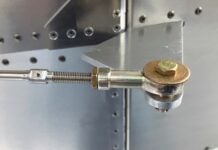The floating nut plate. It sounds like it should come with an allergy warning, but this is KITPLANES, not Pinterest, so we are discussing fasteners that allow components to be installed and removed with a single tool, not a trending party snack. Like a normal nut, nut plates (or anchor nuts) have a threaded hole that accepts a screw or bolt, but they also have two holes used to affix them permanently to an airframe, usually with rivets. Think of them as nuts that can’t fall when the screw or bolt is removed. Think of them as nuts that require no tools to keep them from rotating while a screw or bolt is installed or removed. Think of them every time you don’t have to think of getting a helper, or duct-taping a combination wrench to the inside of your firewall, to swap out a faulty fuel pump.
Floating nut plates ease and speed the removal and installation of commonly removed airframe components but can themselves be fiddly to install.
A standard nut plate is a one-piece fastener with the three holes (one for a screw or bolt, the other two for mounting rivets) at fixed distances from each other, like modern, contoured car seats where three passengers are locked in place by sculpted upholstery, and no one has any flexibility in where they sit. A floating nut plate is a two-piece fastener (though both pieces are joined during the manufacturing process) with the mounting holes at a fixed distance from each other, but the threaded hole (for a screw or bolt) is free to move or float a bit, like an old-timey bench car seat where the middle passenger is offered a degree of movement (“Mom, Kelly’s touching me!”). That float makes it easier to align and install fasteners when the mounting holes in a component lack precision. Notice I said “holes” in a component, plural, not “hole” in a component. Using a floating nut plate for a component with a single mounting hole is mostly unnecessary. Use a standard nut plate for those applications.
Now, 336 words in, we are to the crux of this article: It can be difficult to accurately drill the three holes for a floating nut plate because it has one hole that moves. With my remaining word allotment, I will share my drilling technique.
1. Get a standard nut plate whose mounting holes match those of the floating nut plate(s) you are installing and use it as a drilling template.
You only need one standard nut plate regardless of the number of floating nut plates you are installing. Use a nut plate for an 8-32 screw even if you will be installing a floating nut plate for a larger screw. The 8-32-sized nut plates accept a silver (#40) Cleco well, which is ideal for steps 2 and 3.
There it is. That’s my technique. For some of you, that’s enough. For those who want or need more, here’s more:
2. Drill a 3/32-inch (or #40) hole where the bolt or screw will pass through the airframe skin and engage the nut plate.
3. Place the standard nut plate over the hole and secure it with a silver Cleco.
4. Rotate the nut plate to get the holes for the attaching rivets into the desired position.
5. Drill one of the rivet holes using the hole in the lug as a drill guide and install a Cleco. Nut plates are typically fastened with 3/32-inch rivets, so a #40 drill works well.
6. Drill the remaining rivet hole.
7. Remove the nut plate.
8. Enlarge the hole that the screw or bolt will pass through. To accommodate the full range of movement of the floating portion of the nut plate, look on the back (flat side) of the floating nut plate. There you will find a similar clearance hole built into the nut plate. Match that diameter for the hole you drill in the airframe skin. There is no point in using a floating nut plate if the hole through the skin limits the float.
9. Deburr and, if necessary, dimple or countersink the holes.
10. Rivet the nut plate to the airframe.
Installing floating nut plates can be fiddly work. This technique should speed the process and improve your accuracy. A variation of this technique is to make a drilling template from a scrap of aluminum sheet. If care is taken to get the template’s hole spacing accurate (I recommend all three holes in your template be no larger than 3/32 inch [#40] diameter), the template can speed the drilling process even further. You’ll need to drill through the template carefully, however, as excessive or careless drilling will enlarge its holes, producing subpar results.
Part of the fun (and reward) of homebuilding is finding ways to make repetitive tasks faster and challenging tasks easier. If you have to install floating nut plates, I hope you find this technique ticks both of those boxes.















Just as an aside, Aircraft Spruce, Omega Technologies, (and others, I’m sure) make a drill jig just for the purpose of drilling accurate nutplate holes